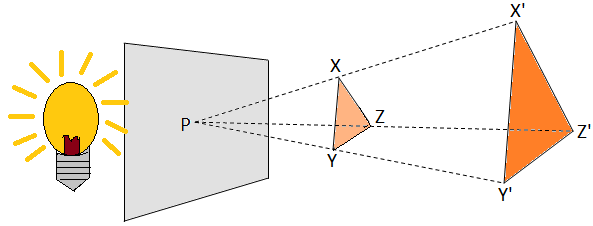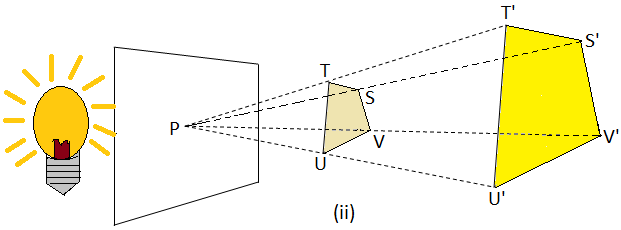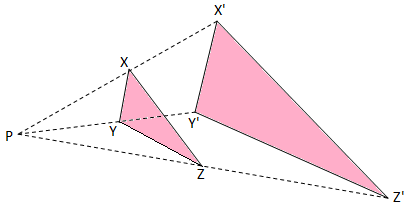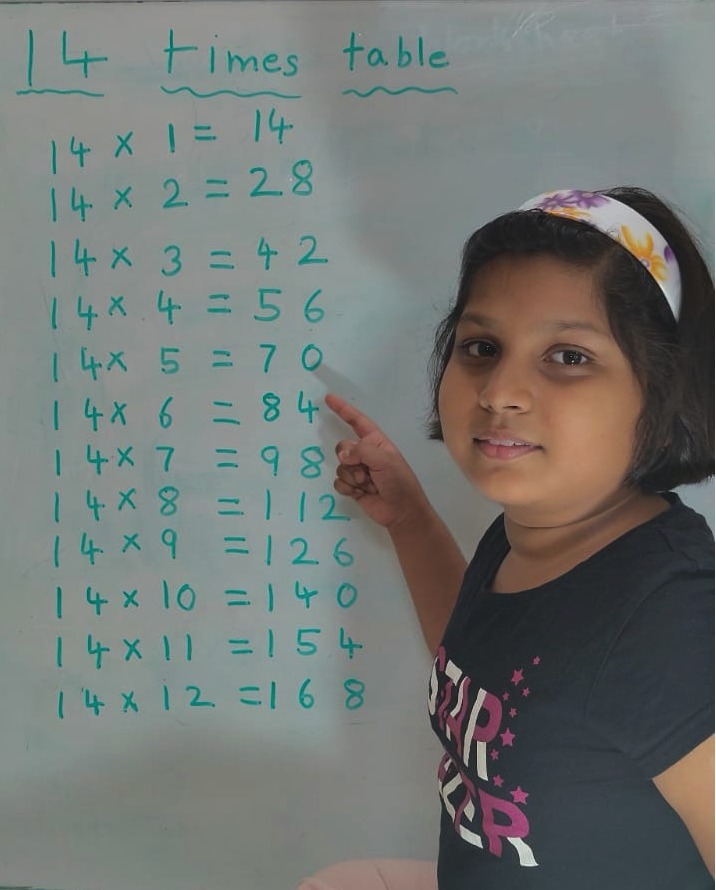Enlargement Transformation
We will discuss here about the similarity on enlargement transformation.
Cut out some geometrical figures like triangles, quadrilaterals, etc., from a piece of cardboard. Now we will hold these figures, one-by-one, between a point source of light and a wall. Then look at the shadow cast by each figure on the wall. The shadows have the same shapes as the original figures, but are larger in size. The shadows are said to be similar to the original figures.
In the above figure, XYZ is a triangle and its shadow is ∆X’Y’Z’.
By actual measurements it can be seen that ∠X = ∠X’, ∠Y = ∠Y’ and ∠Z = ∠Z’.
Thus, the two triangles are equiangular. Also, the shadow X’Y’Z’ is an enlarged image of the object XYZ. If the side X’Y’ = k × XY, the other sides are also enlarged in the same proportion,
i.e., Y’Z’ = k × YZ and Z’X’ = k × ZX.
Here k is said to be the enlargement factor and X′Y′XY = Y′Z′YZ = Z′X′ZX = k.
The point P is known as the centre of enlargement.
Similarly, in the figure
below, the quadrilateral S’T’U’V’ is the enlarged image of the
quadrilateral STUV.
Here also, ∠S = ∠S’, ∠T = ∠T’, ∠U = ∠U’ and ∠V = ∠V’. If the enlargement factor m, we get S′T′ST = T′U′TU = U′V′UV = V′S′VS = m.
Solved Examples on Enlargement Transformation
1. A triangle XYZ has been enlarged by a scale factor 3 to a triangle X’ Y’ Z’. Find the length of:
(i) X’ Y’ if XY = 4 cm,
(ii) YZ if Y’ Z’ = 7.5 cm.
Solution:
Let X′Y′XY = Y′Z′YZ = Z′X′ZX = k.
(i) X′Y′XY = k.
⟹ X′Y′4cm = 3
⟹ X’ Y’ = 3 × 4
⟹ X’ Y’ = 12
(ii) Y′Z′YZ = k.
⟹ 7.5YZ = 3
⟹ YZ = 7.5cm3
⟹ YZ = 2.5 cm
2. A triangle XYZ has been enlarged to ∆ X’Y’Z’ about the centre of enlargement O by a scale factor 2.5.
Find:
(i) X’Y’ if XY = 4 cm,
(ii) XZ if X’Z’ = 15 cm,
(iii) OX’ and XX’ if OX = 3 cm.
Solution:
(i) X′Y′XY = k.
⟹ X′Y′4cm = 2.5
⟹ X’Y’ = 4 × 2.5 cm
⟹ X’Y’ = 10 cm
(ii) X′Z′XZ = k.
⟹ 15cmXZ = 2.5
⟹ XZ = 15cm2.5
⟹ XZ = 6 cm
(iii) OX′OX = k.
⟹ OX′3cm = 2.5
⟹ OX’ = 3 × 2.5 cm
⟹ OX’ = 7.5 cm
XX’ = OX’ - OX = 7.5 cm - 3 cm = 4.5 cm
From Enlargement Transformation to HOME PAGE
Didn't find what you were looking for? Or want to know more information about Math Only Math. Use this Google Search to find what you need.
Recent Articles
-
Vertical Subtraction | Examples | Word Problems| Video |Column Method
Mar 22, 25 05:20 PM
Vertical subtraction of 1-digit number are done by arranging the numbers column wise i.e., one number under the other number. How to subtract 1-digit number vertically? -
Worksheet on 11 Times Table | Printable Multiplication Table | Video
Mar 22, 25 05:08 PM
Worksheet on 11 times table can be printed out. Homeschoolers can also use these multiplication table sheets to practice at home. -
Worksheet on 10 Times Table | Printable Multiplication Table | Video
Mar 21, 25 03:46 PM
Worksheet on 10 times table can be printed out. Homeschoolers can also use these multiplication table sheets to practice at home. -
5th Grade Prime and Composite Numbers | Definitions | Examples | Math
Mar 21, 25 12:18 AM
5th grade prime and composite numbers -
14 Times Table | Read and Write Multiplication Table of 14| Video
Mar 20, 25 04:03 PM
In 14 times table we will learn how to read and write multiplication table of 14. We read fourteen times table as:One time fourteen is 14 Two times fourteen are 28 Three times fourteen are 42








New! Comments
Have your say about what you just read! Leave me a comment in the box below. Ask a Question or Answer a Question.